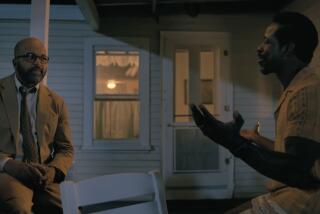BOOK REVIEW : A Passionate Look at Robert Louis Stevenson : DREAMS OF EXILE; Robert Louis Stevenson: a Biography <i> by Ian Bell</i> ; Henry Holt, $296, 25 pages
- Share via
So personally edgy and nudgy is Ian Bell’s book on Robert Louis Stevenson, that it almost could be called “Louis and Me.” It is a biography but there are times when it suggests a memoir--remarkably, since Stevenson died in 1895 and Bell, who is the Scottish editor of London’s Observer, is presumably in the prime of life.
The author tells us he is not a scholar; and “Dreams of Exile” seems to uncover few details of his subject’s much-written-about life. Bell, whose book has been warmly praised in Britain for its passion and emotional empathy, is not after details about Stevenson.
He is after Stevenson whole, somewhat as the journalist Stanley was after the explorer Livingstone. The latter was alive, of course, giving rise to the celebrated “Dr. Livingstone, I presume.”
Stevenson not being alive, Bell’s presumption goes to resuscitating him with jolts of high-voltage prose. Sometimes persuasively but more often crudely, Bell seizes his subject round the waist, dances him through his life, chides or praises his footwork and re-fights his battles, as well as a few that Stevenson perhaps might not have fought or not so hard.
Admitting that he does not like her, Bell paints a fairly hostile portrait of Stevenson’s wife Fanny, an adventurous, literarily ambitious and undoubtedly eccentric American widow 10 years older than he. He concedes that her coolness toward the first draft of “Dr. Jekyll and Mr. Hyde” goaded Stevenson into blasting out--60,000 words in six days from an invalid--a much improved final version, but complains that her criticism “was not very sensitive.”
Bell attractively portrays Lloyd, Stevenson’s beloved stepson, as the enthralled audience for each successive chapter of “Treasure Island.” Later, when Lloyd grows up, collaborates with his stepfather on “The Wreckers” and fights for credit, Bell remarks: “There are times when an admirer of Stevenson wishes the pushy young protege had fallen overboard in the South Seas.” Does Bell--no slouch at pushiness himself--imagine himself there to deliver a shove?
When Stevenson breaks with W.E. Henley for suggesting in a private letter to him that Fanny had plagiarized a short story she published, Bell concedes the plagiarism but grows at least as vitriolic as his subject. “The aging, blustering viceroy of English letters,” he calls Henley.
Bell succeeds best when he restrains himself. He limits his literary judgments but they are perceptive. He senses the uncomfortable Gothic shadow over “A Child’s Garden of Verses” (Stevenson spent a lot of his childhood bedridden and hearing ghost stories from his Scottish nurse). He praises the strength and freedom of “Treasure Island” and “Kidnapped,” and suggests as other critics have done that Stevenson’s last, unfinished work, “Weir of Hermiston,” showed signs of carrying his writing to new levels.
Henry James was a supporter and admirer, and Bell nicely links these two entirely different artists: both believed that writing does not reflect reality but creates it.
In his narrative, Bell provides some well-told background. He evokes Edinburgh, where Stevenson grew up in the mid-19th Century. It was two towns: the prosperous, strait-laced New Town and the brawling, disreputable Auld Reekie. Stevenson, born and raised in prosperity, was a mixture of Bohemianism and caution. Ill for most of his life with the tuberculosis that would kill him at 44, his health forced him to travel; and traveling, as Bell points out, freed him to write.
There were long stays in France, where he met Fanny, and the final years in the South Seas, where he became a hero to the Samoans and fought for their rights.
The best portrait is of Stevenson’s father, Thomas, a civil engineer who was religious, hard-working and apparently severe. He loathed his son’s beliefs and wanderings and all but worshiped him.
The picture of an upright Victorian in steady meltdown is irresistible. We learn that it was the elder Stevenson who suggested the apple barrel that Jim Hawkins hides in.
There is something appealing about Bell’s passion. But by embracing Stevenson so closely, by virtually walking in his boots, by making overwrought prose do the work of the imagination, he blurs him. It seems stingy for a biography to have no illustrations at all. I do want to see Stevenson’s stiff grandfather, I do want to see Stevenson at six months in his bunting, I do want to see him with unnamed companions on the veranda at Vailima, Samoa. But if there were photographs, I am absurdly persuaded that one would show Bell standing a little in front of his subject, pointing him out.
More to Read
Sign up for our Book Club newsletter
Get the latest news, events and more from the Los Angeles Times Book Club, and help us get L.A. reading and talking.
You may occasionally receive promotional content from the Los Angeles Times.










